|
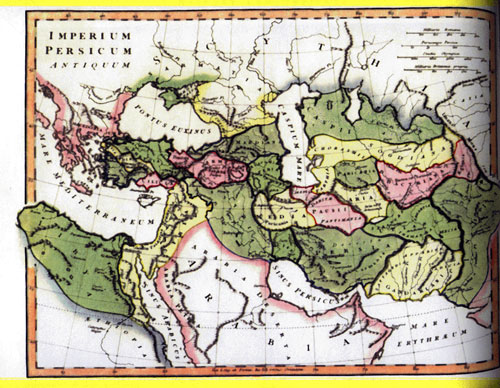
An early-nineteenth century map of the Persian Empire at
the time of Darius the Great, the third of the Achaemenian
King of Kings (522-486 B.C.) This map also shows the
twenty-two satrapie of the empire, each of which contained
a royal garden.
The Achaemenian spear established Persia's empire, an
empire that covered nearly two million square miles and absorbed nations
from Libya to India and from Greece to Ethiopia. The Achaemenian
government united the disparate peoples under a single rule, leaving them their cultures and their gods,
tying them together through far-reaching
chains of communication and sophisticated administration. The
Achaemenian genius, it seems, was for synthesis, in governing as in the
arts of civilization.
Thus the imperial culture that Cyrus and his descendants
created was a rich tapestry of many colors: Entirely new, it was woven
from threads as old as civilization itself. Achaemenian palaces
derived their style from those of subject peoples. Assyrians, Egyptians,
Babylonians, and Greeks, among others, built those soaring royal halls,
and all the peoples of the empire brought as tribute the objects that
adorned the buildings and their great gardens.
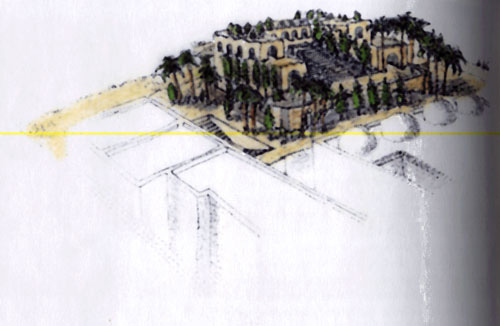
For these were garden palaces, with vast colonnades open
to the walled green spaces that surrounded them, and throne rooms
overlooking reflecting pools and groves of trees. They were
paradises in an austere wilderness; in fact, paradise derives from the Old
Persian pairi-daeza, "a walled space." The Greeks adapted
the word as paradeisos to describe the gardens of the Persian
Empire, and Greek translations of the Bible used this word as the term for
the Garden of Eden and for heaven. Modern Persian uses the arabized
version ferdows. As the word implies, the gardens of the Persian
kings embodied the images of sacred myth. To ancient man, the entire
natural world was charged with meaning: The gods were everywhere and
immanent. As might be expected in a region where all
of human existence depended upon agriculture, particular
power resided in water and trees, and the Mesopotamian
idea of an everlasting, ever-fruitful paradise was already
thousands of years old by Achaemenian times.
Fragments of the earliest known writing - that of
Mesopotamian Sumer of 2800 B.C. - include a poem
describing the creation of such a paradise, ordered by the
water god ad provided by the god of the sun. The
Sumerian epic of Gilgamesh, only slightly less ancient,
presents an immortal garden, centered on a sacred tree
that stand beside a holy fountain. The concept was
universal in Semitic myth. 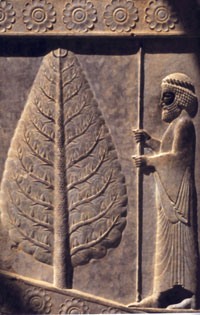
The earliest historical records about
the Achaemenian "paradise" are those of the Greek author
Xenophon (ca 431-355 B.C.), a disciple of Socrates. In 401 B.C. he
describes the passion of Darius I for gardens: "....in all the
districts he resides in and visits, he takes care that there are
'paradises,' as they call them, full of all the good and beautiful things
that the soil will produce......." And in his Anabasis, he
expresses admiration for the way in which Cyrus the Younger (424-401
B.C.), the son of Darius and satrap of Lydia, looked after his large
garden at Sardis, which he had designed himself and in which he had
planted some of the trees with his own hands. As for the Persian'
love for shade trees, Herodotus describes how Xerxes, during his long
campaign against the Greeks in 480 B.C., stopped on the royal route and
saw a plane tree, the sacred tree of the Iranian plateau, which was so
majestic and beautiful that he decorated it with golden ornaments and appointed
a lifetime guard to watch over it!
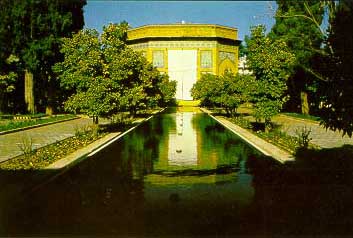
As
the empire grew ever richer from the tributes of its
provinces-the famous satrapies - such paradises
proliferated. The Achaemenians were builders on a
grand scale. Cyrus began the restoration of the old
Elamite capital at Susa, Darius and Artaxerxes expanded it
to a city of palaces and courtyards covering more than
seven acres, all organized around a central garden.
Susa was a winter administrative capital. To escape
the summer heat on the plain, the court moved with the
season to Ecbatana, the ancestral capital of the Medes six
thousand feet high in the Zagros, where the modern city of
Hamadan now lies. Inside the ring of seven walls set
to guard the city, they planted terraced gardens of great
magnificence. And the kings ordered paradises, with
trees in orderly rows and aromatic plants, created at the
satrapal palaces as well, so that the idea and the plants
spread throughout the ancient world. Thus Darius I
commending the garden of the satrap Gadatas in Asia
Minor: " It is evident that you devote your
attention to cultivating the land that belongs to me,
since you transplant into Lower Asia trees that grow on
the other side of the Euphrates; I laud your diligence in
this matter, and for it you shall enjoy great favor from
the House of the King." In fact, the import and
export of plants was a deliberate policy of empire.
The Achaemenians, according to the archaeologist Roman
Chirshman, introduced pistachios to Aleppo, sesame to
Egypt, and rice to Mesopotamia. Of
all the palaces that at Perseoplis, begun by Darius,
expanded by Xerxes and Artaxerxes I, pillaged and burned
in 330 B.C. during Alexander of Macedon's conquest,
remains the emblem of Achamenian glory. Yet it is
the one where paradise is difficult to imagine:
Although the architecture incorporates such plant forms as
the lotus, the rosette, the palm, and the fir tree, these
are lost on the impregnable platform fifty feet high, with
its reversing staircases wide enough for eight men to walk
abreast, its giant doorways, its fallen columns. The
plant become insignificant beside the endless processions
of subject peoples bearing gifts, the winged Assyrian
bulls that guard the gatehouse, the enormous mythological
animals and griffins that served as capitals for the
columns. To
recall the Achaemenian garden, it is better to return to
the tomb of Cyrus, the first and greatest of the Kings of
Kings, at Pasargadae. It is a lofty building, the
peak of its gabled roof rising forty feet above the
treeless, plowed fields around. Its monumental
simplicity has moved the hearts of generations. When
in 330 B.C. Alexander the great paused to salute it, he
found it set in a garden. According to Alexander's
biographer, the first-century Greek historian Arrian,
"The tomb of this Cyrus was in the territory of the
Pasargadae, in the royal park; round it had been planted a
grove of all sorts of trees; the grove was irrigated, and
deep grass had grown in the meadow...." The
tomb was a place of pilgrimage for Cyrus's successors, for
Alexander, and for other soldiers paying homage to
greatness. Some of them left their names carved on
the walls. In later centuries, as Cyrus was
forgotten, the tomb was named "The Shrine of
Solomon's Mother." A mehrb "altar"
facing toward Mecca was carved inside the building.
Beside it, village women praying for fertility hung bits
of votive cloth. 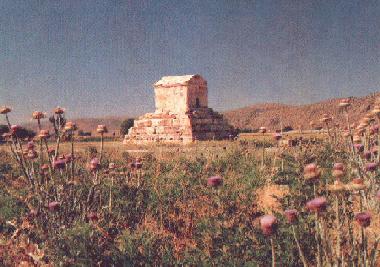
|